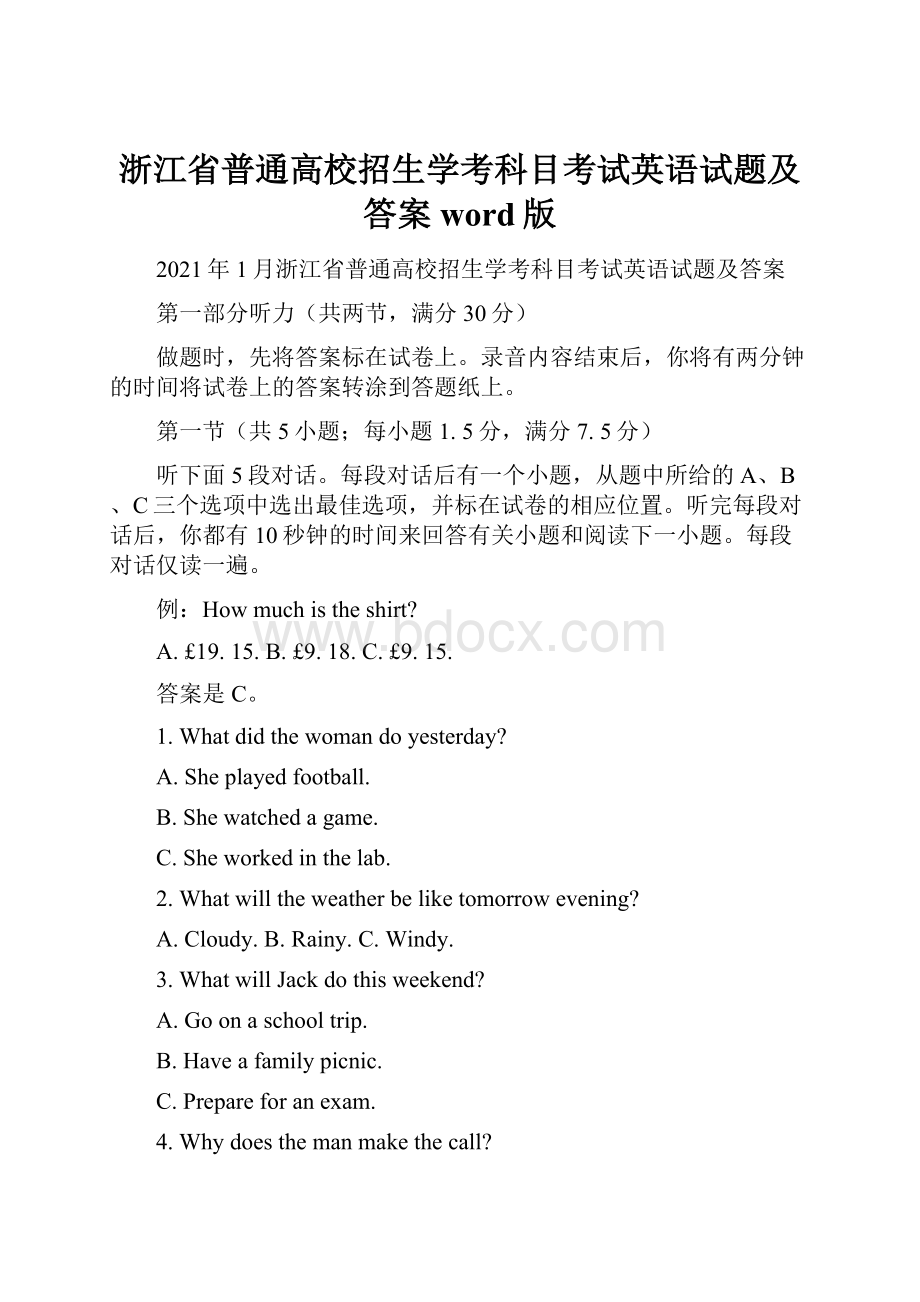 浙江省普通高校招生学考科目考试英语试题及答案 word版.docx
浙江省普通高校招生学考科目考试英语试题及答案 word版.docx
- 文档编号:26819987
- 上传时间:2023-06-23
- 格式:DOCX
- 页数:13
- 大小:24.49KB
浙江省普通高校招生学考科目考试英语试题及答案 word版.docx
《浙江省普通高校招生学考科目考试英语试题及答案 word版.docx》由会员分享,可在线阅读,更多相关《浙江省普通高校招生学考科目考试英语试题及答案 word版.docx(13页珍藏版)》请在冰豆网上搜索。

浙江省普通高校招生学考科目考试英语试题及答案word版
2021年1月浙江省普通高校招生学考科目考试英语试题及答案
第一部分听力(共两节,满分30分)
做题时,先将答案标在试卷上。
录音内容结束后,你将有两分钟的时间将试卷上的答案转涂到答题纸上。
第一节(共5小题;每小题1.5分,满分7.5分)
听下面5段对话。
每段对话后有一个小题,从题中所给的A、B、C三个选项中选出最佳选项,并标在试卷的相应位置。
听完每段对话后,你都有10秒钟的时间来回答有关小题和阅读下一小题。
每段对话仅读一遍。
例:
Howmuchistheshirt?
A.£19.15.B.£9.18.C.£9.15.
答案是C。
1.Whatdidthewomandoyesterday?
A.Sheplayedfootball.
B.Shewatchedagame.
C.Sheworkedinthelab.
2.Whatwilltheweatherbeliketomorrowevening?
A.Cloudy.B.Rainy.C.Windy.
3.WhatwillJackdothisweekend?
A.Goonaschooltrip.
B.Haveafamilypicnic.
C.Prepareforanexam.
4.Whydoesthemanmakethecall?
A.Toarrangeameeting.
B.Tocancelavisit.
C.Toaskforassistance.
5.Howdoesthemanfeelnow?
A.Refreshed.B.Anxious.C.Sleepy.
第二节(共15小题;每小题1.5分,满分22.5分)
听下面5段对话或独白。
每段对话或独白后有几个小题,从题中所给的A、B、C三个选项中选出最佳选项,并标在试卷的相应位置。
听每段对话或独白前,你将有时间阅读各个小题,每小题5秒钟;听完后,各小题将给出5秒钟的作答时间。
每段对话或独白读两遍。
听第6段材料,回答第6、7题。
6.Whatistheprobablerelationshipbetweenthespeakers?
A.Husbandandwife.B.Hostessandguest.C.Chefandcustomer.
7.Whatisthemanmostlikelytohavefordinner?
A.Frenchfries.B.Hamsandwiches.C.Fishandvegetables.
听第7段材料,回答第8至10题。
8.WherewillGeorgegoafterthebusinesstrip?
A.Milan.B.Rome.C.Florence.
9.WhatisbannedinFlorence?
A.Eatinginthestreet.
B.Dressingupassoldiers.
C.Singingonpublictransport.
10.WhatdoesGeorgethinkofthenewrules?
A.They'reeffective.B.They'retimely.C.They'rereasonable.
听第8段材料,回答第11至13题。
11.WhydoesMs.McDanieltalktoFrank?
A.Hemissedaspeech.
B.Hefailedtopassatest.
C.Hewantedtodropaclass.
12.HowwouldMs.McDaniel'sstudentsreactifaspeakermadeamistake?
A.laughatthespeaker.
B.Sympathizewiththespeaker.
C.Persuadethespeakertotryagain.
13.HowdoesMs.McDanielsound?
A.Optimistic.B.Humorous.C.Encouraging.
听第9段材料,回答第14至16题。
14.Whatmakesthemansurprised?
A.Thenumberofjobapplicants.
B.Theexperienceofemployees.
C.Thecandidates'languageskills.
15.Howmanycandidatesarethespeakersgoingtomeet?
A.2.B.12.C.20.
16.Whatdothespeakerstalkaboutattheendoftheconversation?
A.Jobdescription.
B.Interviewprocedure.
C.Candidates'background.
听第10段材料,回答第17至20题。
17.WhatdidGalloreceiveyesterday?
A.Acallfromhersister.
B.Abottlefromheraunt.
C.Aletterfromastranger.
18.Wheredidthefishermanfindthebottle?
A.OnMonheganIsland.
B.AtCumberland.
C.InSpain.
19.HowoldwasGallowhenshethrewoutthebottle?
A.Fight.B.Eleven.C.Fourteen.
20.Whereisthebottlenow?
A.Intheocean.B.AtGallo'shome.C.Withthefisherman.
第二部分阅读理解(共两节,满分35分)
第一节(共10小题;每小题2.5分,满分25分)
阅读下列短文,从每题所给的A、B、C和ID四个选项中,选出最佳选项,并在答题纸上将该项涂黑。
Morethan25yearsago,SarooBrierleylivedinrural(农村)India.Oneday,heplayedwithhisbrotheralongtheraillineandfellasleep.Whenhewokeupandfoundhimselfalone,the4-year-olddecidedhisbrothermightbeonthetrainhesawinfrontofhim-sohegoton.
Thattraintookhimathousandmilesacrossthecountrytoatotallystrangecity.Helivedonthestreets,andtheninanorphanage(孤儿院).There,hewasadoptedbyanAustralianfamilyandflowntoTasmania.
Ashewritesinhisnewbook,ALongWayHome,Brierleycouldn'thelpbutwonderabouthishometownbackinIndia.Herememberedlandmarks,butsincehedidn'tknowhistown'sname,findingasmallneighborhoodinavastcountryprovedtobeimpossible.
Thenhefoundadigitalmappingprogram.Hespentyearssearchingforhishometownintheprogram'ssatellitepictures.In2011,hecameacrosssomethingfamiliar.Hestudieditandrealizedhewaslookingatatown'scentralbusinessdistrictfromabird's-eyeview.Hethought,“Ontheright-handsideyoushouldseethethree-platformtrainstation”—andthereitwas."Andontheleft-handsideyoushouldseeabigfountain"-andthereitwas.Everythingjuststartedtomatch.
Whenhestoodinfrontofthehousewherehegrewupasachild,hesawaladystandingintheentrance."There'ssomethingaboutme,"hethought—andittookhimafewsecondsbuthefinallyrememberedwhatsheusedtolooklike.
InaninterviewBrierleysays,"MymotherlookedsomuchshorterthanIremembered.Butshecameforthandwalkedforward,andIwalkedforward,andmyfeelingsandtearsandthechemicalinmybrain,youknow,itwaslikeanuclearfusion(核聚变).Ijustdidn'tknowwhattosay,becauseIneverthoughtseeingmymotherwouldevercometrue.AndhereIam,standinginfrontofher.”
21.WhywasBrierleyseparatedfromhisfamilyabout25yearsago?
()
A.Hegotonatrainbymistake.
B.Hegotlostwhileplayinginthestreet.
C.Hewastakenawaybyaforeigner.
D.HewasadoptedbyanAustralianfamily.
22.HowdidBrierleyfindhishometown?
()
A.Byanalyzingoldpictures.
B.BytravellingallaroundIndia.
C.Bystudyingdigitalmaps.
D.Byspreadinghisstoryviahisbook.
23.WhatdoesBrierleymainlytalkaboutintheinterview?
()
A.Hisloveforhismother.
B.Hisreunionwithhismother.
C.Hislongwaybackhome.
D.Hismemoryofhishometown.
B
Atthestartofthe20thcentury,anAmericanengineernamedJohnElfrethWatkinsmadepredictionsaboutlifetoday.Hispredictionsaboutslowingpopulationgrowth,mobilephonesandincreasingheightwereclosetothemark.Buthewaswronginoneprediction:
thateverybodywouldwalk10milesaday.
Today,inAustralia,mostchildrenonaveragefall2,000stepsshortofthephysicalactivitytheyneedtoavoidbeingoverweight.Intheearly1970s,40percentofchildrenwalkedtoschool,whilein2010,itwasaslowas15percent.
Thedeclineisnotbecausewehaveallbecomelazy.Familiesarepressedfortime,manywithbothparentsworkingtopayfortheirhouse,oftenworkinghoursnotoftheirchoosing,livingincar-dependentneighborhoodswithlimitedpublictransport.
Theothersideofthecoinisequallyadeprivation:
forhealthandwell-being,aswellaslostopportunities(机会)forchildrentogettoknowtheirlocalsurroundings.Andforparentstherearelostopportunitiestowalkandtalkwiththeiryoungscholarabouttheirday.
Mostparentswillhaveeagerlyaskedtheirchildabouttheirday,onlytomeetwitha“good”,quicklyfollowedby"I'mhungry".Thisisalsomyexperienceasamother.Butsomewhereoverthedailywalkmoreaboutmyson'sdaycomesout.Ihearhimmakingsenseoffriendshipanditslimits.Thisistheunexpectedandrareparentalopportunitytohearmore.
Manyprimaryschoolssupportwalkingschool-busroutes(路线),withdaysofregular,parent-accompaniedwalks.Doingjustoneoftheseafewtimesaweekisbetterthannothing.Itcanbetoughtobeginandtakesalittleplanning-runningshoesbythefrontdoor,lunchesmadethenightbefore,umbrellasonrainydaysandhatsonhotones-butit'scertainlyworthtrying.
24.WhydoestheauthormentionWatkins'predictionsinthefirstparagraph?
()
A.Tomakecomparisons.B.Tointroducethetopic.
C.Tosupportherargument.D.Toprovideexamples.
25.WhathascausedthedecreaseinAustralianchildren'sphysicalactivity?
()
A.Plainlaziness.B.Healthproblems.
C.Lackoftime.D.Securityconcerns.
26.Whydoestheauthorfindwalkingwithhersonworthwhile?
()
A.Shecangetrelaxedafterwork.B.Shecankeepphysicallyfit.
C.Shecanhelpwithherson'sstudy.D.Shecanknowhersonbetter.
C
Researcherssaytheyhavetranslatedthemeaningofgesturesthatwildchimpanzees(黑猩猩)usetocommunicate.Theysaywildchimpscommunicate19specificmessagestooneanotherwitha"vocabulary"of66gestures.ThescientistsdiscoveredthisbyfollowingandfilminggroupsofchimpsinUganda,andexaminingmorethan5,000incidentsofthesemeaningfulexchanges.
DrCatherineHobaiter,wholedtheresearch,saidthatthiswastheonlyformofintentionalcommunicationtoberecordedintheanimalkingdom.Onlyhumansandchimps,shesaid,hadasystemofcommunicationwheretheydeliberatelysentamessagetoanothergroupmember.
"That'swhat'ssoamazingaboutchimpgestures,"shesaid."They'retheonlythingthatlookslikehumanlanguageinthatrespect.”
Althoughpreviousresearchhasshownthatapesandmonkeyscanunderstandcomplexinformationfromanotheranimal'scall,theanimalsdonotappeartousetheirvoicesintentionallytocommunicatemessages.Thiswasasignificantdifferencebetweencallsandgestures,DrHobaitersaid.
Chimpswillchecktoseeiftheyhavetheattentionoftheanimalwithwhichtheywishtocommunicate.Inonecase,amotherpresentsherfoottohercryingbaby,signaling:
"Climbonme."Theyoungsterimmediatelyjumpsontoitsmothersbackandtheytravelofftogether."Thebigmessagefromthisstudyisthatthereisanotherspecies(物种)outthere.thatismeaningfulinitscommunication,sothat'snotuniquetohumans,"saidDrHobaiter.
DrSusanneShultz,anevolutionarybiologistfromtheUniversityofManchester,saidthestudywaspraiseworthyinseekingtoenrichourknowledgeoftheevolutionofhumanlanguage.But,sheadded,theresultswere"alittledisappointing".
"Thevaguenessofthegesturemeaningssuggestseitherthatthechimpshavelittletocommunicate,orwearestillmissingalotoftheinformationcontainedintheirgesturesandactions,"shesaid."Moreover,themeaningsseemtonotgobeyondwhatotheranimalconveywithnon-verbalcommunication.So,itseemsthegulfremains."
()27.WhatdochimpsandhumanshaveincommonaccordingtoDrHobaiter?
A.Memorizingspecificwords.B.Understandingcomplexinformation.
C.Usingvoicestocommunicate.D.Comm
- 配套讲稿:
如PPT文件的首页显示word图标,表示该PPT已包含配套word讲稿。双击word图标可打开word文档。
- 特殊限制:
部分文档作品中含有的国旗、国徽等图片,仅作为作品整体效果示例展示,禁止商用。设计者仅对作品中独创性部分享有著作权。
- 关 键 词:
- 浙江省普通高校招生学考科目考试英语试题及答案 word版 浙江省 普通高校 招生 科目 考试 英语试题 答案 word
 冰豆网所有资源均是用户自行上传分享,仅供网友学习交流,未经上传用户书面授权,请勿作他用。
冰豆网所有资源均是用户自行上传分享,仅供网友学习交流,未经上传用户书面授权,请勿作他用。


 《C12343098汽轮机操作规程》要点.docx
《C12343098汽轮机操作规程》要点.docx
